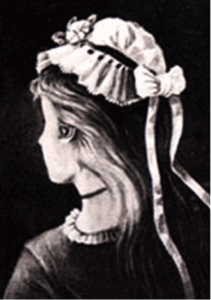G’day again
Adults are always asking little kids what they want to be when they grow up because they’re looking for ideas.
Paula Poundstone
What makes this quote funny?
Discussions of what causes the jolt of mirth which we enjoy when reading aphorisms and quirky quotes, turn on the fact that the beginning of the quote anticipates an ending which is flipped by a contrary or unlinked or totally unexpected ending. Adults should know what they want to be – they in fact are the ones who are supposed to guide the youngsters! But (however) …
Many books have been written on the subject and many have come from serious writers and mathematicians – see Martin Gardner’s various comments on humour, or John Allen Paulos’ “I think, therefore I laugh” and “Mathematics and Humor”
In fact, the very beauty of this kind of humour is that it offers us a way to break free from our expectations and ‘understandings’ of how life should be and of how life in fact is.
Do we have a choice in what we see and how we understand and appreciate much of what we experience in life?
Another binary optical illusion
This very well-known visual illusion illustrates clearly how much of life is coloured by our expectations and our conditioning. Some people see a picture of an old woman, and some people see a picture of a young woman.
Who is right?
You would be surprised at how much conflict this kind of disparity can generate!
And it goes much further than this and in fact the way someone sees and understands or appreciates such visual flip-flops is often an indication of various aspects of their psyche – a kind of elementary Rorschach.
Where am I going with all of this?
I don’t know!!!
Maybe I can suck something out of the air and offer something useful.
Ah, yes, Mindfulness!
‘parently developing mindfulness skills allows people to break away from their fixed understandings and known rules of right and wrong, and to learn to experience the world in the here-and-now, sans judgements and pre-conceptions. So in the case of the illusion above, it offers a flavour to the spectator, of the possibility of different understandings and experiences from just one stimulus. So there is a clear shift from ‘right and wrong’ to ‘this-as-well-as-that. The woman is neither old nor young but she exists in the reality of the observer, from moment to moment.
(Quantum physics is hot on this too, but that is a different discussion. As a note, in quantum physics, an observer in fact creates reality and by the current most accepted understanding of one of the paradoxes of quantum physics, there in fact is no reality until the observer of the quantum ‘superposition’ {a ‘thingy’ not yet in existence but about to come into existence by the mere fact of an observer observing}, actually observes the quantum state of superposition, and instantly, a whole world of reality it is created merely by the act of observation. Whether it is the act of observation by the observer or in fact it is when the observation enters the consciousness of the observer, is yet a further matter. Complicated it certainly is!).
Back to the prosaics of modern simple life, in fact, “The ability to seek and find meaning in life is based more than anything on the capacity to hold paradox and maintain an unblushing cognitive dissonance” – Remen R.N. Kitchen Table Wisdom. Sydney, Australia: Pan Macmillan, 2002.
Once the paradox of the old/young woman is revealed, any ‘conflict’ about ‘who is right’, just falls away. Both the person who sees ‘old’ and the person who sees ‘young, are right (or wrong).
‘Parently mindfulness lets people become accustomed to experiencing the world in strikingly useful ways.
So, what is Mindfulness?
Don’t ask me! How the hell should I know? Go do a Google!!
Maybe I can just write about it a bit.
The concept of being ‘Mindful’ has been around for thousands of years, but only in the last 50 years or so has Mindfulness begun to be a vital concept in the West, in many areas of life, including mental health.
Way back in 1950’s, one of the first books on mindfulness was published – Shaddock E.H. An Experiment in Mindfulness. London, UK: Rider and Company, 1958, and the author describes his experiences of learning Mindfulness in Rangoon. It is a didactic and clinical account of his experiences, coming as it did while the whole idea of Mindfulness was still in its infancy in the West. So the book is descriptive and has the flavour of reporting, as opposed to the flavour of being something to be engaged in as a matter of vivified living.
In the 60’s and 70’s, Mindfulness began to enter into Western consciousness, popularised and comprehensively offered by, amongst others, the then gurus, Richard Alpert and Alan Watts.
Richard Alpert, (Ram Dass), was formerly a professor at Harvard University, is an American spiritual teacher and the author of the seminal 1971 book “Be Here Now”.
Alan Watts was a British-born philosopher, writer, and speaker, best known as an interpreter and populariser of Eastern philosophy for a Western audience.
These two luminaries represented amongst the first serious academic shifts towards a heretofore esoteric, non-empirically validated approach to spiritual and coherent living. Today of course, there is a whole slew of research and serious writing on the benefits of mindfulness, all validating the enormous benefits of being able to curiously and non-judgementally observe life and, in fact, observe oneself observing life.
As a consequence of the opening up of Mindfulness as a clinically crucial skill to acquire, many new clinical approaches to the ‘treatment’ of mental health disorders and indeed dysfunctional life, all emphasise the benefits of acquiring mindfulness skills.
For those of you who are interested to know a bit more about mindfulness, do a Google. There are any number of useful and informative definitions of mindfulness, all emphasizing the deliberate, purposeful, curious observing of sensations, feelings, experiences, emotions as they arise, with a curious acceptance of everything that does come up and a noticing of any urges to change the experience as it arises.
A whole slew of Mindfulness based clinical approaches to helping people struggling with life issues, have shifted to the forefront of clinically crucially useful psychological approaches to the ‘treatment’ of both psychological disorders and to spiritual guidance in general. For a comprehensive guide to some of these approaches, see: Baer, Ruth A. Mindfulness-Based Treatment Approaches. Amsterdam: Elsevier, Academic Press, 2006. Print.
And in education, one of the earlier seminal works on mindfulness was Ellen Langer – Langer, Ellen J. Mindfulness. Reading, Mass.: Addison-Wesley Pub. Co., 1989. Print.
Now, how did I get to Mindfulness when the post is on humour? And on humour in the clinical setting?
I have no idea at all!
Somehow, it seems to me that the ability to enjoy paradox, to be free enough to hold divergent ideas and realities, to revel in difference and otherness, is one of the keys to a rich, full and meaningful life.
And I know that when I laugh, when I am free to enjoy life with the gusto of hearty enjoyment and delight and pleasure, I know that I am alive.
Michael Cohn – 18th May 2015

